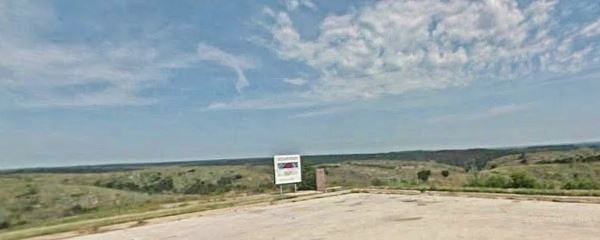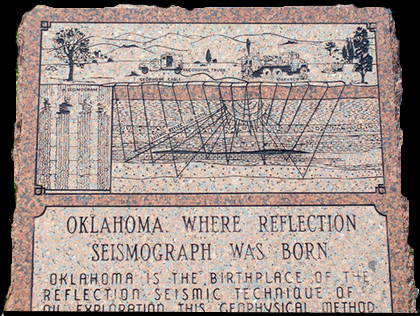Scientists experiment with reflection seismography in 1921.
Exploring seismic waves is all about the vital earth science technology — reflection seismography — which revolutionized petroleum exploration in the 1920s. Seismic waves have led to oilfield discoveries worldwide and billions of barrels of oil.
Seismic technologies evolved from the effort to locate enemy artillery during World War I. The new way of finding petroleum reserves came from several competing post-war inventors — but two experiments by a University of Oklahoma physicist stood out in the summer of 1921.

A geological description and granite marker stand at I-35 near Ardmore, Oklahoma, commemorating the 1921 test of seismic technologies.
“Oklahoma is the birthplace of the reflection seismic technique of oil exploration,” proclaims the state’s historical society in granite at a Murray County historic marker off I-35, next to a detailed illustration of the area’s geology (sponsored by the Ardmore Geological Society).
Seismic Waves
“This geophysical method records reflected seismic waves as they travel through the earth helping to find oil bearing formations,” the Oklahoma Historical Society (OHS) noted on its marker northeast of Ardmore.

The Ardmore Geological Society’s I-35 roadside marker describes how scientists chose the Arbuckle Mountains to test seismic surveying in 1921, “because an entire geologic section from the Basal Permian to the basement mass of granite is exposed.”
Seismic technologies have been responsible for discovering the world’s largest petroleum reserves, many containing billions of barrels of oil and trillions of cubic feet of natural gas. The exploration advancement came thanks to pioneering research led by Prof. John Clarence Karcher.
The first reflection seismograph geologic section was measured during experiments near Oklahoma City and Ardmore in the summer of 1921.
OU Earth Science
The University of Oklahoma’s Prof. Karcher, raised on a farm at Hennessey, in 1916 received both electrical engineering and physics degrees from O.U. His early field tests of seismic technologies led to a small Oklahoma mountain range.
“The Arbuckle Mountains of Oklahoma were selected for a pilot survey of the technique and equipment, because an entire geologic section from the Basal Permian to the basement mass of granite is exposed,” the OHS noted, adding that limited testing previously was done on June 4, 1921, on the outskirts of Oklahoma City.
One month later, John Karcher and fellow O.U. professors William Haseman and David Ohern, were joined by Irving Perrine of Cornell University to continue verification and confirmation testing. The pioneering earth scientists were among the first members of the American Association of Petroleum Geologists (AAPG), founded in 1917 in Tulsa.

A monument on I-35 commemorates 1921 experiments resulting in the first successful measurement of a geologic section.
Funded by an Oklahoma City independent producer, Karcher, Haseman and Ohern formed the Geological Engineering Company. The experiments indicated that their seismograph could reveal subsurface structures capable of holding oil.
Seismology finds Oilfields
“The world’s first reflection seismograph geologic section was measured on August 9, 1921, along vines branch, a few miles north of Dougherty near here,” according to the marker.
“The reflection technique has become the major method of energy exploration throughout the world,” the marker notes. “By 1983 more than 70 percent of the 18,600 members of the Society of Exploration Geophysicists (SEG) in 112 countries were involved in reflection.”
Seismic technology first helped find oil when Amerada Petroleum Corporation drilled into the Viola limestone formation and struck oil on December 4, 1928, near Seminole, Oklahoma. The well was the world’s first oil discovery in a geological structure that had been identified by reflection.
Other discoveries followed as the new exploration technology revealed dozens of oilfields (learn more in Seminole Oil Boom). The 1928 seismic survey, conducted by subsidiary Geophysical Research, used technologies that had evolved from the experiments of Karcher and his Oklahoma University colleagues. But those scientists were not alone.
WWI Artillery
During World War I, inventors Reginald Fessenden and Ludger Mintrop independently contributed to the new earth science. Work by Fessenden, a Canadian who was chief physicist for the Submarine Signaling Company of Boston, helped make the technology smaller and more practical for the field. Mintrop, a Germann, was equally important.

Seismic wave paths reflect from the top of bedrock to detectors on the land surface. Image courtesy Geologic Resources.
Meanwhile, Mintrop developed portable seismic detection equipment to locate Allied artillery for the German Imperial Army. But as Oklahoma historians have noted, the Karcher seismic design dates back to 1917, when he was an employee of the U.S. Bureau of Standards.
“Both the German and American versions, crude contrivances at best, were intended for use in locating enemy artillery by measuring the seismic vibrations produced by their firing,” OHS explained.
Father of Reflection Seismography
Although both Mintrop and Karcher, who was president of Geophysical Research, would secure patents, Karcher’s apparatus dramatically changed petroleum exploration worldwide. His methodology — and his 1928 Seminole oil discoveries — earned him the title “Father of Reflection Seismography.”
Learn more Sooner State petroleum history by visiting Oklahoma oil and gas museums.
_______________________
Recommended Reading: Trek of the Oil Finders: A History of Exploration for Petroleum (1975); Oil And Gas In Oklahoma: Petroleum Geology In Oklahoma (2013). Your Amazon purchase benefits the American Oil & Gas Historical Society. As an Amazon Associate, AOGHS earns a commission from qualifying purchases.
_______________________
The American Oil & Gas Historical Society (AOGHS) preserves U.S. petroleum history. Please become an AOGHS annual supporter and help maintain this energy education website and expand historical research. For more information, contact bawells@aoghs.org. Copyright © 2025 Bruce A. Wells. All rights reserved.
Citation Information – Article Title: “Exploring Seismic Waves.” Authors: B.A. Wells and K.L. Wells. Website Name: American Oil & Gas Historical Society. URL: https://aoghs.org/technology/exploring-reflection-seismography. Last Updated: December 1, 2024. Original Published Date: April 29, 2013.



